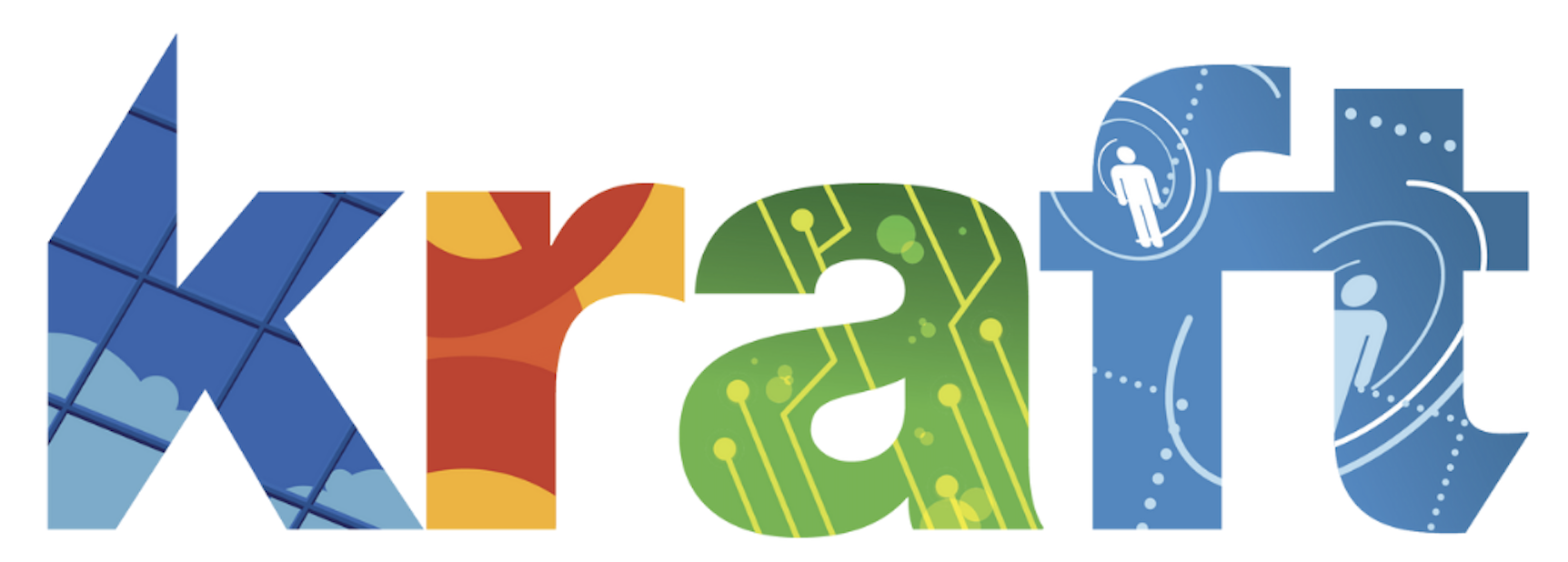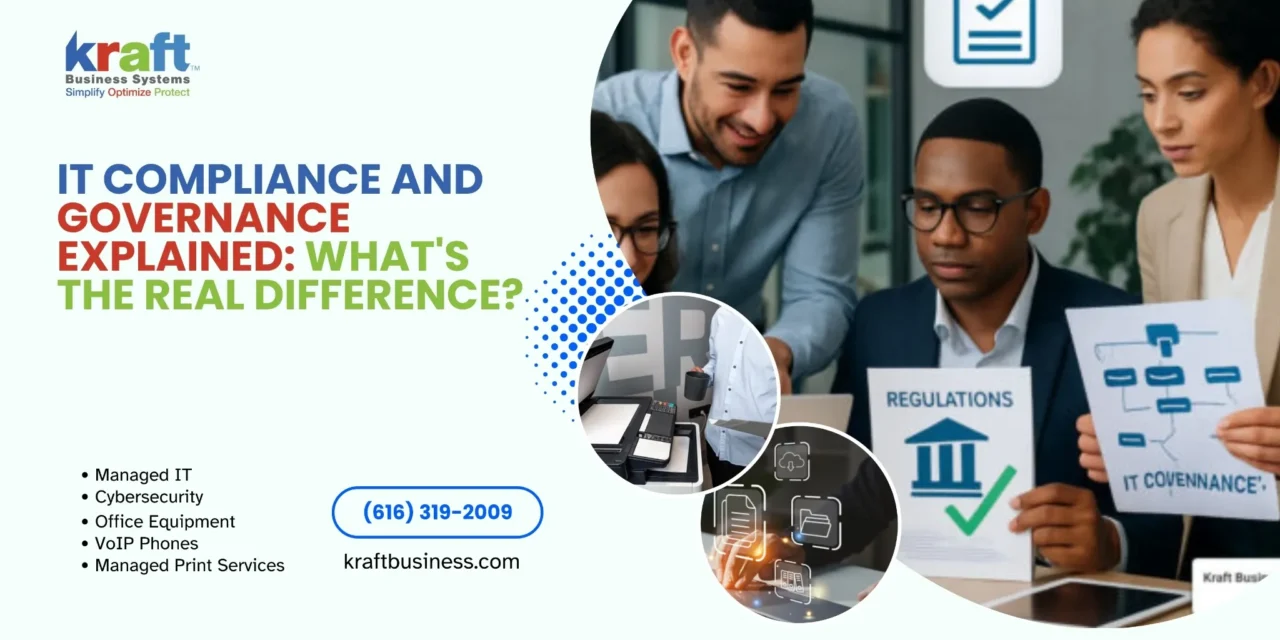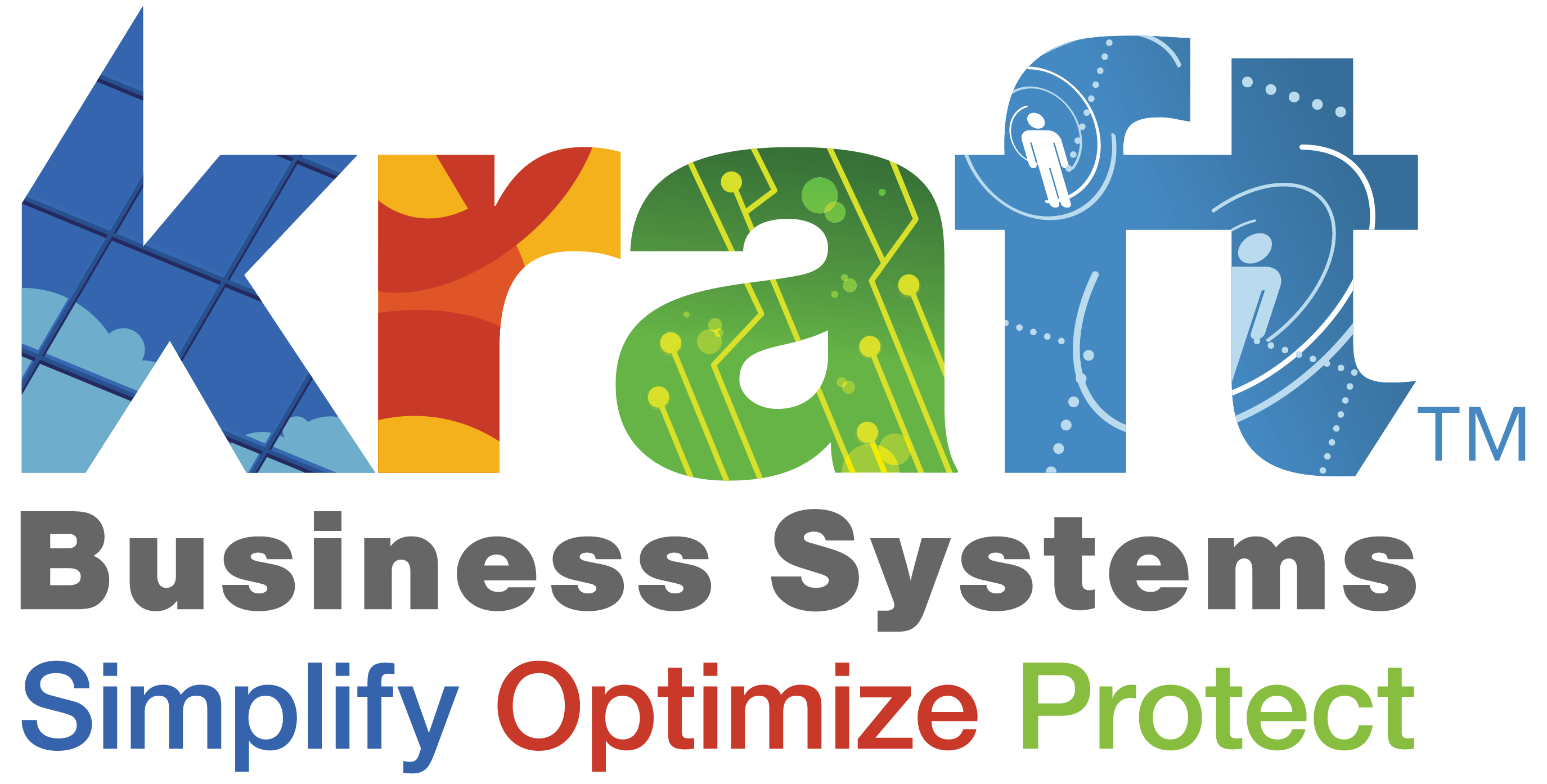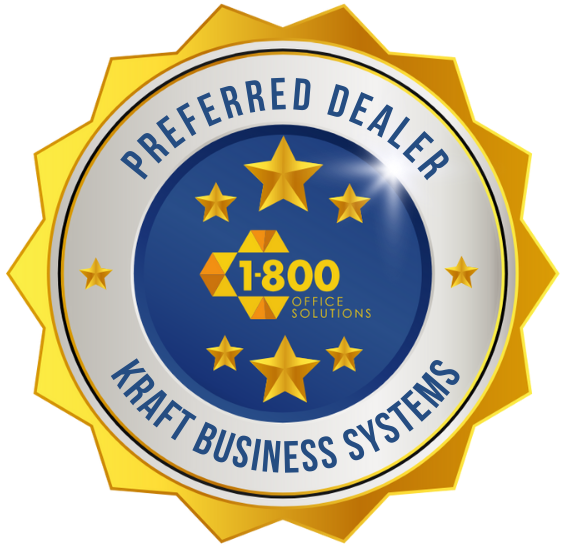IT compliance and governance might sound like business buzzwords that mean the same thing, but they’re actually distinct concepts with different purposes. Think of them as two sides of the same coin – both essential, yet serving separate functions.
Let’s break down what makes each unique:
| IT Governance | IT Compliance |
|---|---|
| Focus: Strategic alignment of IT with business goals | Focus: Meeting legal and regulatory requirements |
| Source: Internal policies and decision frameworks | Source: External laws, regulations, and standards |
| Nature: Voluntary, defines how decisions are made | Nature: Mandatory, defines what must be done |
| Objective: Value creation and operational efficiency | Objective: Risk mitigation and avoiding penalties |
| Timeframe: Long-term, strategic | Timeframe: Immediate, operational |
Many businesses struggle to distinguish between these two areas. While both fall under the GRC (Governance, Risk, and Compliance) umbrella, they serve fundamentally different purposes in your organization.
Did you know that companies with strong IT governance typically see better financial results? Research shows that organizations with above-average IT governance performance achieve more than 20% higher profitability than those with poor governance practices. That’s because good governance creates a framework for making smart technology decisions that align with your business goals.
IT governance is like the brain of your technology strategy – it determines direction, establishes accountability, and ensures you’re getting maximum value from your tech investments.
IT compliance, on the other hand, is your shield. It protects your business by making sure you follow all the necessary rules – whether that’s HIPAA regulations for healthcare data, PCI DSS standards for payment processing, or GDPR requirements for customer privacy.
For you as a business leader, understanding this difference matters. You need both elements working together: governance to drive value and innovation, and compliance to protect your organization from potentially devastating legal and financial consequences.
Consequences of getting it wrong
The price of poor IT compliance and governance can be steep. Data breach costs now average over $4.35 million per incident, while regulatory fines can reach into the millions depending on the violation. Beyond these direct costs, operational downtime during security incidents or compliance investigations can bring your business to a standstill.
Perhaps most damaging is the loss of customer trust. When clients learn their data has been compromised due to compliance failures, that relationship damage can be impossible to repair. Many businesses never fully recover from major compliance failures.
The good news? Many of the systems that support good governance also help with compliance, creating opportunities for efficiency. Identity and Access Management (IAM) serves as the backbone for both areas, ensuring the right people have appropriate access to systems and data.
Automation tools can dramatically reduce the workload of maintaining both governance and compliance programs. When properly implemented, shared controls across encryption, access management, and monitoring can reduce your Total Cost of Ownership by up to 40% compared to managing these functions separately.
Smart businesses recognize that IT compliance and governance work best when integrated, creating a comprehensive approach to managing technology risks while maximizing business value. Check out our guide to IT Compliance Risk Assessment to learn more about building this integrated approach.
IT Compliance and Governance 101: Definitions, Objectives, Benefits
Let’s unpack what IT compliance and governance actually mean before exploring their differences. Think of them as two essential pieces of the same puzzle – different in purpose but equally vital to your organization’s success and security.
IT Governance Basics
Think of IT governance as the compass that guides your technology decisions. It’s the framework that ensures every dollar spent on IT actually helps move your business forward. Good governance answers questions like “Who makes technology decisions?” and “How do we know our IT investments are paying off?”
“GRC is overarching. It sets the tone and the strategy; it defines the policies and the procedures and what the expectations are,” explains Lisa McKee from ISACA’s Emerging Trends Working Group.
At its core, IT governance focuses on strategic alignment between your tech initiatives and business goals. It creates value delivery by maximizing returns on IT investments while optimizing resource management. Proper governance also handles risk management by identifying potential technology pitfalls before they become problems, and establishes clear performance measurement so you know exactly how well your IT is performing.
For governance to work, your leadership team must be actively involved. Your board sets direction and expectations, while management implements the framework through practical policies and procedures that everyone can follow.
IT Compliance Basics
While governance is about making smart choices, compliance is about following the rules – and there are plenty of them. IT compliance means adhering to all those laws, regulations, and industry standards that dictate how you must protect and manage your systems and data.
“This level of complexity requires a robust GRC framework to assist an organization with avoiding reputational damage and legal penalties,” notes Chris Stanley, an ISC2 content developer.
Compliance isn’t optional. It involves first identifying which regulations apply to your specific organization. You’ll need to conduct thorough risk assessments to find any compliance gaps that could lead to problems. Then comes implementing controls – both technical safeguards and procedural guidelines to ensure you’re following the rules.
Meticulous documentation is essential because in compliance, if it isn’t documented, it might as well not have happened. Finally, ongoing monitoring and reporting keeps everything in check and demonstrates your compliance status when auditors come knocking.
Unlike governance’s internal focus, compliance requirements come from external authorities – government agencies, industry regulators, and standards organizations that set the rules you must follow.
IT compliance and governance in context
IT compliance and governance both fit under the broader GRC (Governance, Risk, and Compliance) umbrella, working together to protect your organization while enabling growth. As OCEG founder Scott Mitchell puts it, “GRC ensures businesses don’t just meet requirements but operate better overall.”
The relationship between these two elements is deeply intertwined. Governance creates the cultural foundation and framework that makes compliance possible. Compliance, in turn, provides specific requirements that your governance structure must address. Both rely on similar controls and technologies, and both contribute to your overall risk management strategy and organizational resilience.
Despite their importance, many organizations struggle to get this right. A 2023 survey of over 1,300 risk and compliance professionals revealed that only 53% rated their programs as mature, while 20% described them as early stage. This highlights the ongoing challenge many businesses face in developing truly effective Governance, Risk, and Compliance Explained strategies.
The most successful organizations don’t view governance and compliance as separate activities but as complementary parts of a continuous improvement cycle that strengthens the entire business. When properly implemented, they don’t just protect your organization – they help it thrive.
Governance vs Compliance: Key Differences, Overlaps, Risks
Let’s clear up the confusion between IT compliance and governance once and for all. While they work hand-in-hand, understanding their distinct roles helps you implement both more effectively.
Think of governance as your internal compass and compliance as your external rulebook. Here’s how they differ:
| Aspect | IT Governance | IT Compliance |
|---|---|---|
| Source of requirements | Internal leadership and stakeholders | External regulators and authorities |
| Mandatory vs. voluntary | Largely voluntary and self-imposed | Mandatory with legal consequences |
| Key objective | Optimize IT value and strategic alignment | Avoid penalties and legal issues |
| Timeframe | Long-term, future-focused | Immediate, present-focused |
| Flexibility | Adaptable to business changes | Rigid adherence to fixed standards |
| Measurement | Value creation, efficiency, ROI | Pass/fail, audit findings, penalties avoided |
| Primary stakeholders | Board, executives, shareholders | Regulators, auditors, legal authorities |
As Tilcia Toledo from FTI Consulting smartly puts it: “Risk is about where the organization wants to play and where it does not want to play. It is about those boundaries it does not want to cross at this time.” Governance draws these boundaries from within, while compliance enforces the lines drawn by outside authorities.
Consequences of getting it wrong
The price of poor IT compliance and governance can hit your business where it hurts most.
When governance falls short, you’ll likely face misaligned IT investments that don’t support what your business actually needs. This leads to wasted resources, budget overruns, and inefficient operations with teams duplicating efforts. Decision-making becomes murky without clear authority, and you might miss golden strategic opportunities because your technology can’t keep up.
Compliance failures pack an even heavier punch. You could face substantial financial penalties (GDPR violations can cost up to €20 million or 4% of global annual revenue, whichever hurts more). Beyond fines, there’s legal liability, potential lawsuits, and reputational damage that can drive customers away for good. Your operations might face disruption or restrictions, and executives could even face personal liability.
Want to avoid these headaches? A thorough IT Compliance Risk Assessment helps identify vulnerabilities before they become problems.
The good news? IT compliance and governance often rely on the same control mechanisms, creating opportunities to work smarter, not harder.
Identity and Access Management (IAM) serves as the backbone for both – controlling who can access what and maintaining detailed audit trails. The same security monitoring tools that keep you compliant also provide governance oversight of your risk management efforts.
Your policy management framework can efficiently address both governance directives and compliance requirements. And the documentation and reporting you create for compliance audits can inform smarter governance decisions.
Smart businesses leverage these overlaps. Industry data shows implementing a unified GRC framework can cut total cost of ownership by up to 40% compared to managing these functions in separate silos.
As John A. Wheeler from Gartner Research wisely notes: “IT risks have been managed in silos, but are increasingly being recognized as leading indicators for failure in other risk areas, such as fraud, and resiliency.” This highlights why an integrated approach to IT compliance and governance makes so much business sense.
By understanding both the differences and shared elements between governance and compliance, you create a stronger foundation for managing technology risks while maximizing business value. Proper implementation of both helps you not just avoid problems but actively drive your business forward.
Frameworks & Standards You Need to Know
Navigating the alphabet soup of IT compliance and governance frameworks can feel overwhelming. Think of these frameworks as recipe books written by experts who’ve already figured out what works. Let’s break down the ones you actually need to know about – no fluff, just practical guidance.
Key Governance Frameworks
When it comes to governance, several frameworks stand out for their comprehensive approach and industry acceptance.
COBIT (Control Objectives for Information and Related Technologies) is like the gold standard of IT governance. Developed by Information Systems Audit and Control Association (ISACA), COBIT helps you align your tech decisions with business goals. The latest version, COBIT 2019, offers flexibility that previous versions lacked – perfect if you’re looking to integrate it with other frameworks you might already use.
If service delivery is your focus, ITIL (Information Technology Infrastructure Library) should be on your radar. Think of ITIL as your guide to ensuring your IT services actually meet business needs, from initial strategy through design, transition, operation, and improvement. Many IT departments swear by ITIL for structuring their service delivery.
For those concerned with risk management (and who isn’t these days?), COSO from the Committee of Sponsoring Organizations of the Treadway Commission offers valuable guidance. While not exclusively IT-focused, its principles around risk assessment and control activities translate perfectly to technology governance.
Rounding out the governance frameworks is ISO/IEC 38500, an international standard that provides principles for directors to evaluate, direct, and monitor IT use. It’s particularly helpful if you need to demonstrate good governance practices to stakeholders or board members.
Major Compliance Standards
On the compliance side, several regulations likely apply to your business, depending on your industry and data handling practices.
SOX (Sarbanes-Oxley Act) emerged from corporate financial scandals and focuses on financial reporting and internal controls. If you’re a public company, SOX compliance isn’t optional, and your IT systems need to support accurate financial reporting.
Handling European customers’ data? GDPR is your constant companion. This comprehensive regulation has transformed how organizations worldwide approach data privacy and protection. The potential fines – up to 4% of global annual revenue – have certainly gotten everyone’s attention!
Healthcare organizations face the ever-present HIPAA requirements. Patient data protection isn’t just good practice; it’s the law. HIPAA mandates administrative, physical, and technical safeguards to keep protected health information secure.
If you process credit card payments, PCI DSS is non-negotiable. Created by major credit card companies, it specifies security requirements for anyone handling payment data. Think of it as the minimum security standard expected by the financial industry.
The NIST Cybersecurity Framework deserves special mention for its practical, flexible approach. Organized around five core functions (Identify, Protect, Detect, Respond, and Recover), it provides a sensible structure for organizations of any size to improve their security posture.
Mapping frameworks to your industry
The frameworks that matter most depend largely on your industry. Let’s look at how they map to different sectors.
Financial Services firms operate in one of the most regulated environments. Beyond SOX for public companies, you’ll need to address GLBA for financial privacy, Basel III for risk management, and FFIEC guidelines for IT security. With money on the line, regulators don’t take chances.
In Healthcare, HIPAA dominates the compliance landscape, but it’s not alone. The HITECH Act addresses electronic health records specifically, while FDA regulations cover medical devices. Don’t forget state-specific privacy laws that may impose additional requirements.
Retail businesses must contend with PCI DSS for payment processing and a growing array of consumer privacy laws like CCPA/CPRA in California. ADA compliance for digital accessibility and FTC regulations for customer data protection round out the retail compliance picture.
Small and Medium Enterprises may face fewer industry-specific regulations, but you’re not off the hook. You’ll still need to address general data protection laws, industry standards relevant to your business, and compliance requirements from customers and partners. The good news? Many smaller businesses can implement streamlined approaches that cover multiple requirements simultaneously.
Here’s the silver lining: there’s significant overlap in the technical controls required by different frameworks. Strong access controls, encryption, and monitoring can help you address requirements from multiple regulations at once. This means you can build an efficient compliance program that satisfies multiple frameworks without duplicating efforts.
At Kraft Business Systems, we help Michigan organizations identify which frameworks matter most for their specific situation and implement efficient control structures that address multiple requirements simultaneously. Why build separate controls for different regulations when a unified approach can work better? Check out our GRC Compliance Tools guide to learn more about streamlining your compliance efforts.
From Strategy to Reality: Implementing and Measuring Success
Turning principles into practice is where many organizations struggle with IT compliance and governance. The gap between knowing what to do and actually doing it can feel enormous. Let’s walk through how to bridge that gap with practical steps that work in the real world.
Building the roadmap
Starting your IT compliance and governance journey requires a clear path forward. Think of it as planning a road trip – you need to know where you are, where you’re going, and the best route to get there.
First, take an honest look at your current situation. What governance structures do you already have? Which compliance requirements apply to your business? This assessment helps identify gaps between where you are and where you need to be.
“Most organizations are surprised to find they already have many controls in place,” says Lisa McKee from ISACA. “What they’re often missing is documentation and consistency.”
With gaps identified, it’s time to develop or update your policies. Clear, well-written policies aren’t just paperwork – they’re the foundation of your entire program. They establish who makes decisions, how those decisions get made, and what happens when things go wrong.
Clarity around roles is absolutely crucial. When everyone knows who’s responsible for what, things actually get done. Using a RACI matrix (Responsible, Accountable, Consulted, Informed) can prevent the all-too-common scenario where everyone assumes someone else is handling a critical task.
Perhaps most importantly, don’t underestimate the human element. The best policies in the world won’t help if your team doesn’t understand or follow them. Thoughtful training and change management make the difference between a program that exists on paper and one that truly protects your organization.
Leveraging automation & tools
Let’s be honest – manual compliance and governance is exhausting, error-prone, and nearly impossible to sustain. Smart automation can be a game-changer.
Continuous controls monitoring tools can verify that your security measures are working 24/7, not just when you remember to check them. Instead of scrambling before an audit, these tools collect evidence automatically throughout the year.
One healthcare organization we worked with reduced their quarterly compliance checks from two weeks of full-time work to just a few hours using automated tools. Their team went from dreading audits to confidently handling them with minimal disruption.
Security Information and Event Management (SIEM) solutions serve double duty – supporting both compliance requirements and providing the visibility leadership needs for governance oversight. Similarly, policy management systems ensure consistent messaging across your organization.
The real magic happens when these tools work together. For example, when an employee leaves, an integrated system can automatically revoke their access, document the change for compliance purposes, and notify relevant managers – all without manual intervention.
Measuring IT compliance and governance performance
“What gets measured gets managed” is especially true for IT compliance and governance. Without meaningful metrics, it’s impossible to know if your program is actually working.
Effective measurement goes beyond simple checklists. Yes, tracking the percentage of compliance requirements you’ve satisfied matters, but so does measuring how quickly you address issues when they arise. A program that quickly resolves problems often outperforms one that tries to prevent every possible issue.
Maturity models provide a structured way to evaluate your progress. Rather than the binary “compliant/non-compliant” view, they recognize that improvement happens in stages – from initial ad-hoc processes to optimized, continuously improving systems.
Executive dashboards bring these measurements to life with visual representations that leadership can quickly understand. The best dashboards don’t just show status; they connect IT governance and compliance metrics to business outcomes leadership truly cares about.
As John Wheeler from Gartner wisely notes, IT risks are often “leading indicators for failure in other risk areas.” When you measure and manage them effectively, you’re protecting the entire organization.
At Kraft Business Systems, we help Michigan organizations build practical, effective compliance and governance programs that fit their unique needs. We understand that small and mid-sized businesses face many of the same requirements as large enterprises, but with fewer resources. Our approach focuses on efficient solutions that provide maximum protection without overwhelming your team or budget.
Looking for help with your IT compliance and governance journey? Our IT Compliance Consulting Services can help you steer the complexities, while our expertise in GRC Audit Management and IT Security Risk Assessment ensures you’re building on a solid foundation.
Conclusion
We’ve covered a lot of ground in exploring IT compliance and governance. If there’s one thing to remember, it’s that these aren’t just corporate buzzwords—they’re essential business functions that protect your organization while driving strategic value.
Think of governance as your internal compass, pointing your technology decisions toward business goals and maximizing return on your IT investments. Compliance, meanwhile, is your shield against legal troubles, protecting you from the very real consequences of failing to meet regulatory requirements.
When properly implemented, IT compliance and governance work hand-in-hand. Your governance framework creates the culture and structure that makes compliance possible. At the same time, meeting compliance requirements helps fulfill key governance objectives around risk management and organizational protection.
The numbers tell a compelling story: companies with strong IT governance see 20% higher profitability than their less-governed peers. That’s not just correlation—it’s the direct result of better technology decisions, clearer accountability, and more strategic resource allocation.
What we’ve learned matters for businesses of all sizes. Whether you’re implementing sophisticated frameworks like COBIT and ITIL, or simply starting with basic governance principles, the key is taking that first step toward more intentional technology management.
Successful implementation doesn’t happen overnight. It requires careful planning, clear roles and responsibilities, appropriate technology support, and ongoing measurement. Many organizations find significant efficiency by integrating their governance and compliance efforts, leveraging shared controls and processes to meet both sets of objectives.
Here at Kraft Business Systems, we’ve guided countless Michigan businesses through the complexities of IT compliance and governance. From small businesses just establishing their first formal IT policies to large enterprises navigating complex regulatory environments, we understand the unique challenges you face.
Our team works with organizations across Grand Rapids, Detroit, Lansing and throughout Michigan to transform compliance obligations into strategic advantages. Rather than viewing these requirements as burdens, we help you use them as catalysts for better business practices and more reliable systems.
Ready to strengthen your approach to IT compliance and governance? Explore our comprehensive IT Solutions designed to address your unique challenges and turn technology management into a competitive advantage.
